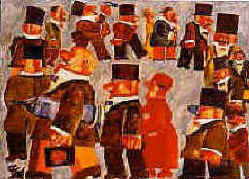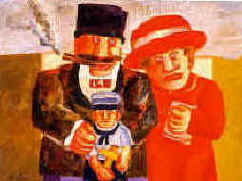


WORKS AND PRESENTATION
PRESENTATION
EXTRACTS FROM MONOGRAPHIES, CATALOGUES AND MAIN NEWSPAPERS
Home Page Public Exhibitions Biography Bibliography International Fairs PublicAuctions
All
the works introduced in this site belong to public and private collections.



Only
one, but this is the conclusion that is (perhaps) important. That is the return
of nation in painting. Nowadays only few can tell stories: someone describes,
many imagine, ever so many believe (believe) to invent. Franz Borghese has
created not only his typology of characters,
nearly his bestiary, but his “idea of men”. In this "idea" - we
must say it - prevails an existential pessimism. Men that perhaps were
originally good, today are no more so. They quarrel, they strur about, they
attack and eat one another. They are egoist and violent, often neurotic. If we
look at the story of culture, all big artists, all big writers have built their
”way”. That of Borghese gets near a storm that is half popular half
intellectual, between Ruzzante (we apologize for the comparison) and Jonathan
Swift. Below we perceive the look of the cultured man, who throws a glance from
the window. People coming and going make him curious and, at the same time,
frighten him. In the end he takes shelter in the ironical detachement, at least
apparently; but below (at least I suppose) there is a sort of torturing
participation, a need of comparison, the attempt to escape the wreck of the soul.
Anyway, the “world” of Borghese remains unmistakable: both if you love it
and if you hate it. It becomes “a pictorial autobiography", made of
interpositions and metaphors. This appears also in his writings and, generally,
in his words. There is an attempt to become virgin again, to take shelter in
ingenuousness (even if he likes more Voltaire than Rousseau), above all to
understand the others. Certainly he lives an everlasting contradiction between
the bottom of his culture and the wish to approach the popular mind. But was it
not the dilemma of big writers as Zola or Hugo as well ? Was it not the worry of
Ensor and Gauguin? So: the “ big scenes story" of Borghese remains
balanced between the aristocracy of culture and the popular anthropology. Here
we meet the cunning fellows and the idiots, the refined persons and the
plebeians. But it is always a tale, pages of a novel, loose sheets. Or, if we
want to transfer the comparison to painting, a medieval fresco: a Biblia
pauperum understood from everybody. This old nineteenth-century tint is only
a trick: an "invented time" for siting the yesterday and today (and
tomorrow too) vicissitudes of mankind. This is more present than the plastic
puppets by Jeff Koons or the serigaphated Marylin by Warhol. It is present because - let’s say it - has an
universality going beyond fashions: and even he makes fun of them, he flouts
them. If we look again at the big Atelier
painting, this is very clear: at the
end we discover also the remotest spots of his (and our) memory... We also are,
certainly, inside the atelier of the painter that pretends to sleep.
Venice 2000
Paolo Rizzi
(Franz Borghese - Galleria Orler - Scoletta dei
Battioro )


